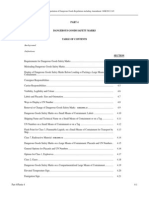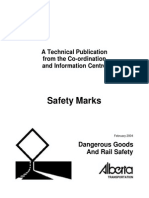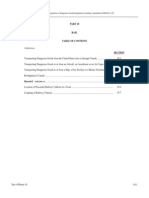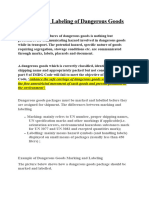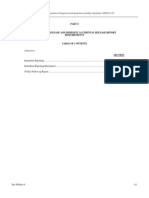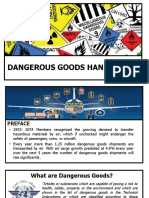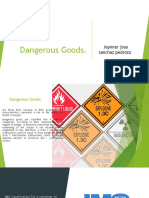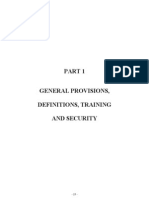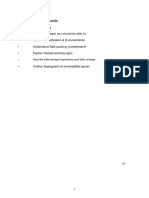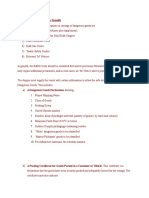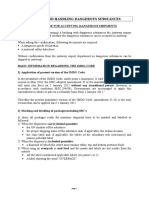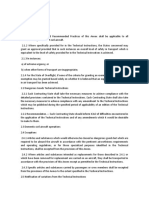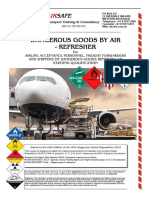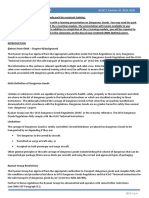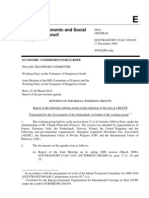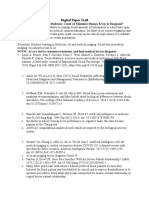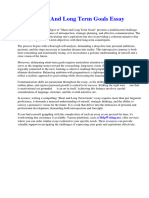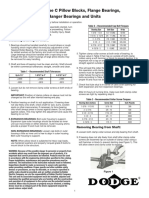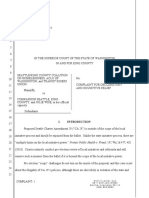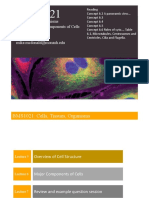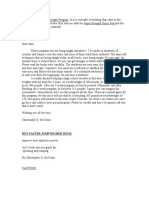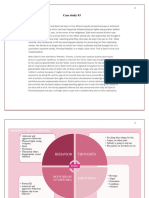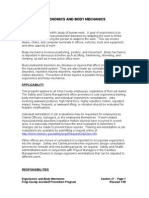05 - m106 - Partie4-7e
Uploaded by
inglevo05 - m106 - Partie4-7e
Uploaded by
inglevoConsolidated Transportation of Dangerous Goods Regulations
including Amendment SOR/2008-34
PART 4
DANGEROUS GOODS SAFETY MARKS
TABLE OF CONTENTS
Background
Definitions
SECTION
Requirements for Dangerous Goods Safety
Marks ...................................................................... 4.1
Misleading Dangerous Goods Safety Marks ........... 4.2
Display of Dangerous Goods Safety Marks Before
Loading or Packing a Large Means of Containment 4.3
Consignor Responsibilities...................................... 4.4
Carrier Responsibilities........................................... 4.5
Visibility, Legibility and Colour ............................. 4.6
Labels and Placards: Size and Orientation .............. 4.7
Ways to Display a UN Number............................... 4.8
Removal or Change of Dangerous Goods Safety
Marks
SOR/2008-34 ............................................................... 4.9
Dangerous Goods Safety Marks on a Small Means
of Containment: Labels ........................................... 4.10
Shipping Name and Technical Name on a Small
Means of Containment or on a Tag ......................... 4.11
UN Numbers on a Small Means of Containment or
on a Tag................................................................... 4.12
Flash Point for Class 3, Flammable Liquids, on a
Small Means of Containment for Transport by Ship 4.13
Class 7, Radioactive Material SOR/2008-34 .................... 4.14
Dangerous Goods Safety Marks on a Large Means
of Containment: Placards and UN Numbers ........... 4.15
General Options for Placards and UN Numbers ..... 4.16
Options for Class 1, Explosives .............................. 4.17
Part 4/Partie 4 4-1
Consolidated Transportation of Dangerous Goods Regulations
including Amendment SOR/2008-34
SECTION
Class 2, Gases ......................................................... 4.18
Dangerous Goods Safety Marks on a
Compartmentalized Large Means of Containment.. 4.19
Elevated Temperature Sign ..................................... 4.20
Fumigation Sign ..................................................... 4.21
Marine Pollutant Mark ............................................ 4.22
Category B Mark SOR/2008-34 ........................................ 4.22.1
APPENDIX Illustration of Dangerous Goods Safety
Marks
Background
Dangerous goods safety marks are required to be displayed on a
means of containment containing dangerous goods in transport.
Dangerous goods safety marks include labels, placards, orange
panels, signs, marine pollutant marks, numbers, letters,
abbreviations and words used to identify dangerous goods and to
show the nature of the danger they pose.
Dangerous goods safety marks give a quick identification of
dangerous goods in the event of an emergency situation such as
an accident or an accidental release of dangerous goods from a
means of containment.
Dangerous goods safety marks are also an awareness tool for
people involved in transportation, including truck drivers, train
crews, loading dock workers, reception personnel at a lab or a
hospital and aircraft loading personnel.
Generally, labels are displayed on small means of containment
and placards are displayed on large means of containment.
The term “home-trade voyage, Class I” is used in this Part and is
not defined in Part 1, Coming into Force, Repeal, Interpretation,
General Provisions and Special Cases, but it is defined in
regulations made under the “Canada Shipping Act”.
4-2 Part 4/Partie 4
Consolidated Transportation of Dangerous Goods Regulations
including Amendment SOR/2008-34
DANGEROUS GOODS SAFETY MARKS
Definitions
Definitions for the following terms, used in this Part, are
provided in Part 1, Coming into Force, Repeal, Interpretation,
General Provisions and Special Cases:
Act emergency response assistance means of transport short-run ferry
aircraft plan or ERAP or ERP offer for transport small means of containment
CANUTEC flash point packing group solid
carrier gas person special provision
49 CFR gross mass prescribed subsidiary class
class import primary class substance
compatibility group infectious substance railway vehicle technical name
consignment in transport road vehicle transport index
consignor large means of containment roll-on roll-off ship UN number
cylinder liquid safety mark UN Recommendations
dangerous goods means of containment ship
dangerous goods safety mark shipping name
4.1 Requirements for Dangerous Goods Safety Marks
(1) A person must not offer for transport, transport or import a
means of containment that contains dangerous goods unless
each dangerous goods safety mark required by this Part and
illustrated in the appendix to this Part, or illustrated in
Chapter 5.2 or 5.3 of the UN Recommendations, is
displayed on it in accordance with this Part.
SOR/2003-273
Part 4/Partie 4 4-3
Consolidated Transportation of Dangerous Goods Regulations
including Amendment SOR/2008-34
(2) Despite subsection (1), a person may, before August 15,
2005, offer for transport, transport or import a small
means of containment that contains dangerous goods if
each dangerous goods safety mark required by the
“Transportation of Dangerous Goods Regulations” in
force on August 14, 2002 has, in accordance with those
Regulations, been displayed on it since that date.
SOR/2003-273
4.2 Misleading Dangerous Goods Safety Marks
As provided for in section 6 of the Act, a person must not
display a prescribed safety mark on a means of containment
or means of transport or at a facility if the mark is
misleading as to the presence of danger or the nature of any
danger.
4.3 Display of Dangerous Goods Safety Marks Before
Loading or Packing a Large Means of Containment
A person must not load or pack dangerous goods into a large
means of containment for transport unless, immediately
before the loading or packing, the large means of
containment has displayed on it the dangerous goods safety
marks that will be required when the loading or packing is
complete.
4.4 Consignor Responsibilities
(1) Before importing dangerous goods or allowing a carrier in
Canada to take possession of dangerous goods for transport,
the consignor must
(a) display or ensure the display of the required dangerous
goods safety marks on each small means of
containment that contains the dangerous goods;
(b) display or ensure the display of the required dangerous
goods safety marks on each large means of
containment that contains the dangerous goods; and
SOR/2008-34
(c) provide to the carrier the dangerous goods safety marks
for the dangerous goods that the consignor is offering
for transport or importing and that are to be transported
in a large means of containment.
(2) The consignor is not required to provide the dangerous
goods safety marks referred to in paragraph (1)(c) if they
(a) are already displayed on the large means of
containment; or
(b) are not the correct ones to display because of the
presence of other dangerous goods in the large means
of containment.
4-4 Part 4/Partie 4
Consolidated Transportation of Dangerous Goods Regulations
including Amendment SOR/2008-34
When the consignor provides the large means of
containment, the consignor displays the dangerous
goods safety marks. When the carrier provides the
large means of containment, the consignor provides
the carrier with the appropriate dangerous goods
safety marks.
4.5 Carrier Responsibilities
The carrier of dangerous goods must
(a) ensure that the required dangerous goods safety
marks remain displayed on the small means of
containment while the dangerous goods are in
transport;
(b) display the required dangerous goods safety marks
on the large means of containment, unless they are
already displayed on it, and ensure that they
remain displayed while the dangerous goods are in
transport; and
(c) provide and display, or remove, the dangerous
goods safety marks if the requirements for
dangerous goods safety marks change while the
dangerous goods are in transport.
SOR/2008-34
4.6 Visibility, Legibility and Colour
Dangerous goods safety marks must be
(a) visible, legible and displayed against a background of
contrasting colour;
(b) made of durable and weather-resistant material that
will withstand the conditions to which they will be
exposed without substantial detachment or
deterioration of their colour, symbols, letters, text or
numbers; and
For example, deterioration is considered substantial if
the colour of the safety mark fades or darkens so that it
is no longer the colour that represents the class of
dangerous goods associated with it.
(c) displayed in the colours specified in
(i) the appendix to this Part, which colours must
conform to the following standards in the
PANTONE ® “Formula Guide”, published by
Pantone Inc., 590 Commerce Boulevard,
Carlstadt, New Jersey 07072-3098, United States:
(A) for blue, PANTONE 285,
Part 4/Partie 4 4-5
Consolidated Transportation of Dangerous Goods Regulations
including Amendment SOR/2008-34
(B) for green, PANTONE 335,
(C) for orange, PANTONE 151,
(D) for red, PANTONE 186, and
(E) for yellow, PANTONE 109,
(ii) Part 172 of 49 CFR, or
(iii) Chapters 5.2 and 5.3 of the UN
Recommendations.
4.7 Labels and Placards: Size and Orientation
(1) Labels and placards must be displayed on a means of
containment as they are illustrated in the appendix to this
Part, that is, a square on a point.
(2) Each side of a label must be at least 100 mm in length with a
line running 5 mm inside the edge. However, except for
dangerous goods included in Class 7, Radioactive Materials,
if that size label, together with the shipping name, technical
name and UN number, cannot be displayed because of the
irregular shape or size of the small means of containment,
each side of the label may be reduced in length by the same
amount to the point where the label, together with the
shipping name, technical name and UN number, will fit that
small means of containment, but must not be reduced to less
than 30 mm.
If 30 mm will not fit, subsection 4.10(4) allows the label to
be displayed on a tag attached to the means of containment.
(3) Each side of a placard must be at least 250 mm in length
and, except for the DANGER placard, have a line running
12.5 mm inside the edge. However, except for dangerous
goods included in Class 7, Radioactive Materials, if that size
placard cannot be displayed because of the irregular shape
or size of the large means of containment, each side of the
placard may be reduced in length by the same amount to the
point where the placard will fit that large means of
containment, but must not be reduced to less than 100 mm.
(4) If the size of a label or a placard is reduced, every symbol,
letter and number required on that label or placard must be
reduced proportionately.
(5) If a large means of containment contains dangerous goods
included in Class 7, Radioactive Materials, and a Class 7
placard is required to be displayed in accordance with this
Part, the means of containment must have displayed on it
the Class 7 placard required or the appropriate optional
Class 7 placard illustrated in the appendix to this Part.
SOR/2008-34
4-6 Part 4/Partie 4
Consolidated Transportation of Dangerous Goods Regulations
including Amendment SOR/2008-34
4.8 Ways to Display a UN Number
(1) A UN number that is required by this Part to be displayed on
a small means of containment or on a tag attached to it must
be displayed in one of the following ways:
(a) next to the primary class label for the dangerous goods;
or
(b) within a white rectangle located on the primary class
label for the dangerous goods, without the prefix
“UN”, but it must not obscure the symbol, class
number, compatibility group letter or text on the label.
UN1203
The illustration showing the UN number to the right of the
placard is an example only and does not indicate a
mandatory position. For example, a wrap-around label may
be used on a cylinder.
(2) A UN number that is required by this Part to be displayed on
a large means of containment must be displayed in black
numerals not less than 65 mm high in one of the following
ways:
SOR/2008-34
(a) on an orange panel placed next to the primary class
placard for the dangerous goods, without the prefix
“UN”; or
(b) within a white rectangle located on the primary class
placard for the dangerous goods, without the prefix
“UN”, but it must not obscure the symbol, class
number, compatibility group letter or text on the
placard.
4.9 Removal or Change of Dangerous Goods Safety
Marks
SOR/2008-34
(1) When dangerous goods safety marks are displayed on a
means of containment in accordance with the
requirements of this Part but the conditions that required
the display of the dangerous goods safety marks change
for any reason, the person having charge, management
or control of the means of containment must determine,
as a result of the new conditions, if the dangerous goods
safety marks must be changed or removed.
Part 4/Partie 4 4-7
Consolidated Transportation of Dangerous Goods Regulations
including Amendment SOR/2008-34
SOR/2008-34
(2) Despite subsection (1), when the DANGER placard is
required or permitted to be displayed on a large means
of containment and the quantity of dangerous goods to
which the placard applies decreases, a person may
continue to display the DANGER placard for those
remaining dangerous goods, in place of any other
placard, until a placard is no longer required by this Part
to be displayed on the large means of containment for
those dangerous goods.
SOR/2008-34
4.10 Dangerous Goods Safety Marks on a Small Means of
Containment: Labels
(1) One label must be displayed on a small means of
containment for the primary class and one for each
subsidiary class set out in column 3 of Schedule 1 for each
of the dangerous goods in transport in the small means of
containment, except that
(a) a label is not required to be displayed on a small means
of containment that is inside another small means of
containment if the other small means of containment
has a label displayed on it and is not opened during
loading or unloading or while the dangerous goods are
in transport;
(b) the oxidizing gas label, illustrated in the appendix to
this Part, must be displayed on a small means of
containment for the following dangerous goods:
(i) UN1072, OXYGEN, COMPRESSED;
(ii) UN1073, OXYGEN, REFRIGERATED LIQUID;
(iii) UN3156, COMPRESSED GAS, OXIDIZING,
N.O.S.; and
(iv) UN3157, LIQUEFIED GAS, OXIDIZING,
N.O.S.;
SOR/2008-34
(c) if the dangerous goods are included in Class 7,
Radioactive Materials, two labels must be displayed on
the small means of containment for the primary class,
and
SOR/2008-34
(d) when the dangerous goods are included in Class 2,
Gases, and are contained in a combination of cylinders
each with a capacity greater than 225 L that are a
single unit as a result of being interconnected through a
piping arrangement, and are permanently mounted on a
structural frame for transport, and have a combined
capacity exceeding 450 L, the combination of cylinders
may be placarded as one large means of containment.
SOR/2008-34
(2) For the subsidiary class of Class 1, the label to be displayed
is the label for Class 1.1, 1.2 or 1.3 illustrated in the
4-8 Part 4/Partie 4
Consolidated Transportation of Dangerous Goods Regulations
including Amendment SOR/2008-34
appendix to this Part.
The dangerous goods that have a subsidiary class of Class 1
are listed in paragraph 2.8(1)(a) in Part 2, Classification,
and have “(1)” shown in column 3 of Schedule 1.
(3) When a label is required to be displayed, it must be
displayed
(a) on any side of the outer surface of a small means of
containment other than the side on which it is intended
to rest or to be stacked during transport;
(b) on or near the shoulder of a cylinder containing
dangerous goods; or
SOR/2002-306
(c) in the case of a label for dangerous goods included in
Class 7, Radioactive Materials, on two opposite sides
of the outer surface of a small means of containment,
other than the side on which it is intended to rest or to
be stacked during transport.
(4) Despite subsection (3), a label with sides that are reduced to
30 mm in length in accordance with subsection 4.7(2) may
be displayed on a tag that is securely attached to a small
means of containment.
4.11 Shipping Name and Technical Name on a Small Means
of Containment or on a Tag
(1) When dangerous goods in transport are in a small means of
containment on which a primary class label for the
dangerous goods must be displayed, the shipping name of
the dangerous goods must be displayed next to the primary
class label.
SOR/2008-34
(2) When dangerous goods in transport are subject to special
provision 16 in Schedule 2 and are in a small means of
containment on which the shipping name is displayed, the
technical name of the most dangerous substance related to
the primary class of the dangerous goods must be displayed,
in parentheses, following the shipping name.
(3) When the primary class label for dangerous goods in
transport is displayed on a tag in accordance with subsection
4.10(4), the shipping name and, when required by
subsection (2), the technical name of the dangerous goods
must also be displayed on the tag.
4.12 UN Numbers on a Small Means of Containment or on a
Tag
(1) When dangerous goods in transport are in a small means of
containment on which the primary class label for the
dangerous goods is displayed, the UN number for the
dangerous goods must be displayed on or next to the
primary class label.
Part 4/Partie 4 4-9
Consolidated Transportation of Dangerous Goods Regulations
including Amendment SOR/2008-34
(2) When the primary class label for dangerous goods in
transport is displayed on a tag in accordance with subsection
4.10(4), the UN number must also be displayed on the tag
on or next to the primary class label.
4.13 Flash Point for Class 3, Flammable Liquids, on a Small
Means of Containment for Transport by Ship
When dangerous goods included in Class 3, Flammable
Liquids, are to be transported by a ship other than a short-
run ferry and are in a small means of containment, the flash
point or the flash point range for the dangerous goods must
be displayed on the small means of containment next to the
shipping name of the dangerous goods or, if there is a
technical name, next to the technical name.
4.14 Class 7, Radioactive Material
SOR/2008-34
(1) For dangerous goods included in Class 7, Radioactive
Material, the label or placard required to be displayed by
this Part must be determined in accordance with the
“Packaging and Transport of Nuclear Substances
Regulations”.
SOR/2008-34
(2) For dangerous goods included in Class 7, Radioactive
Material, the following information must be determined in
accordance with the “Packaging and Transport of Nuclear
Substances Regulations”, and must be displayed on the
primary class label for the dangerous goods:
(a) the name or symbol of the radionuclide, except that if
there is a mixture of radionuclides, the name or symbol
of the most restrictive of the radionuclides in the
mixture; and
(b) the activity and the transport index of the dangerous
goods.
SOR/2008-34
4.15 Dangerous Goods Safety Marks on a Large Means of
Containment: Placards and UN Numbers
SOR/2008-34
(1) A placard and UN number must be displayed in accordance
with the following table on a large means of containment
containing dangerous goods, other than a ship or an aircraft,
if the dangerous goods
(a) are in a quantity or concentration for which an
emergency response assistance plan (ERAP) is
required;
4-10 Part 4/Partie 4
Consolidated Transportation of Dangerous Goods Regulations
including Amendment SOR/2008-34
(b) are included in Class 7, Radioactive Materials, for
which a Category III — Yellow label is required;
(c) are a liquid or gas in direct contact with the large
means of containment;
(d) have a gross mass greater than 500 kg; or
(e) are included in Class 1.1, 1.2, 1.3 or 1.5 and are
(i) not subject to special provision 85 or 86 and
exceed 10 kg net explosives quantity, or
(ii) subject to special provision 85 or 86 and the
number of articles exceeds 1 000.
SOR/2008-34
Part 4/Partie 4 4-11
Consolidated Transportation of Dangerous Goods Regulations
including Amendment SOR/2008-34
TABLE
SOR/2008-34
Column 1 Column 2 Column 3
UN Numbers Required
Item Description Placards Required
1. Dangerous Primary class placard (a) UN number if the
goods have the dangerous goods are a
same UN liquid or gas in direct
number and an contact with the large
ERAP is not means of containment;
required for and
them
(b) if not required in
paragraph (a), the UN
number may be displayed
if the dangerous goods are
in a quantity greater than
4 000 kg and are offered
for transport by one
consignor.
2. Dangerous Primary class placard UN number
goods have the
same UN
number and an
ERAP is
required for
them
3. Dangerous (a) primary class placard None
goods have for those Class 1
different UN dangerous goods that
numbers and an meet any of the
ERAP is not conditions in
required for any subsection (1);
of them
(b) primary class placard
for those Class 7
dangerous goods that
meet any of the
conditions in
subsection (1); and
(c) for the remaining
dangerous goods that
meet any of the
conditions in
subsection (1), the
primary class placard
for each of those
dangerous goods except
that, if two or more
different primary class
placards are required,
the DANGER placard
may be displayed in
place of those primary
class placards.
4. Dangerous (a) primary class placard UN number for each of the
goods have for each of the dangerous goods for which an
different UN dangerous goods for ERAP is required
numbers and an which an ERAP is
ERAP is required;
required for at
least one of
them (b) primary class placard
for those Class 1
dangerous goods that
meet any of the
conditions in subsection
(1);
(c) primary class placard
for those Class 7
dangerous goods that
meet any of the
conditions in subsection
4-12 Part 4/Partie 4
Consolidated Transportation of Dangerous Goods Regulations
including Amendment SOR/2008-34
Column 1 Column 2 Column 3
UN Numbers Required
Item Description Placards Required
(1); and
(d) for the remaining
dangerous goods that
meet any of the
conditions in subsection
(1), the primary class
placard for each of
those dangerous goods
except that, if two or
more different primary
class placards are
required, the DANGER
placard may be
displayed in place of
those primary class
placards.
5. Dangerous Primary class placard for UN number for each of the
goods have each of the dangerous dangerous goods
different UN goods
numbers and an
ERAP is
required for
each of them
(2) If dangerous goods are in a means of containment that is
inside a large means of containment and a placard is
required to be displayed but that placard is not visible from
outside the large means of containment, the placard must
also be displayed on the large means of containment. In
addition, if a UN number is required to be displayed but is
not visible from outside the large means of containment, the
UN number must also be displayed on the large means of
containment.
SOR/2008-34
(3) The placard must be displayed on each side and each end of
a large means of containment, except that the placard may
be displayed on
(a) a frame permanently connected to the large means of
containment, such as a truck frame or a support frame
of the means of containment, if the resulting positions
of the placards and any associated UN numbers are
equivalent to positions on each side and each end of
the large means of containment; or
(b) the front of a truck, instead of on the leading end of a
trailer unit of the truck.
SOR/2008-34
The trailer unit of a truck includes a tank.
SOR/2008-34
(4) A subsidiary class placard must be displayed on each side
and each end of a large means of containment for dangerous
goods for which an emergency response assistance plan is
required and that have a subsidiary class of
(a) Class 1, in which case the subsidiary class placard is
the one illustrated for Class 1.1, 1.2 or 1.3 in the
appendix to this Part;
Part 4/Partie 4 4-13
Consolidated Transportation of Dangerous Goods Regulations
including Amendment SOR/2008-34
(b) Class 4.3 in which case the subsidiary class placard is
the one illustrated for Class 4.3 in the appendix to this
Part;
(c) Class 6.1 and are included in Packing Group I due to
inhalation toxicity, in which case the subsidiary class
placard is the one illustrated for Class 6.1 in the
appendix to this Part; or
(d) Class 8 and the dangerous goods are UN2977,
RADIOACTIVE MATERIAL, URANIUM
HEXAFLUORIDE, FISSILE or UN2978,
RADIOACTIVE MATERIAL, URANIUM
HEXAFLUORIDE, non-fissile or fissile excepted, in
which case the subsidiary class placard is the one
illustrated for Class 8 in the appendix to this Part.
SOR/2008-34
4.16 General Options for Placards and UN Numbers
Despite the requirement for the display of primary class
placards in section 4.15, when two dangerous goods have
different UN numbers but are identified by the same primary
class placard, that placard needs to be displayed only once
on each side and each end of a large means of containment.
4.17 Options for Class 1, Explosives
(1) Despite section 4.15, a placard is not required to be
displayed for explosives that are included in
(a) Class 1.4, except for UN0301, AMMUNITION,
TEAR-PRODUCING, and are in a quantity that is less
than or equal to 1 000 kg net explosives quantity; or
SOR/2008-34
(b) Class 1.4S and are in any quantity.
UN0301 requires an emergency response assistance plan
(ERAP). The ERAP index in column 7 of Schedule 1 for
UN0301 is 75.
SOR/2008-34
(2) Despite section 4.15, only the placard for the explosives
with the lowest division number is required to be displayed
for explosives that are included in more than one division
and are in a large means of containment, except in the
following cases:
(a) when explosives included in Class 1.2 and Class 1.5
are transported together, the placard for Class 1.1 must
be displayed; and
(b) when explosives included in Class 1.4 and Class 1.5
are transported together, the placard for Class 1.5 must
be displayed.
(3) Despite the requirement in section 4.15 for the display of a
4-14 Part 4/Partie 4
Consolidated Transportation of Dangerous Goods Regulations
including Amendment SOR/2008-34
UN number, a UN number is not required to be displayed
for Class 1, Explosives.
4.18 Class 2, Gases
(1) When gases that are included in more than one division of
Class 2, Gases, are transported together on the same road
vehicle and the primary class placards or the UN numbers
for those gases are required to be displayed by section 4.15,
they may be replaced by the DANGER placard and the
primary class placard of the most dangerous gas according
to the following decreasing order and, if required by section
4.15, the UN number:
(a) toxic gas;
(b) flammable gas;
(c) oxidizing gas; and
(d) any other gas.
SOR/2008-34
(2) A flammable gas placard illustrated in the appendix to this
Part and, if required by section 4.15, the UN number must
be displayed in accordance with this Part on a road vehicle
transporting a flammable gas if
(a) a DANGER placard is displayed on the road vehicle in
accordance with subsection (1); and
(b) the road vehicle is to be transported by ship.
SOR/2008-34
(3) When placards are required to be displayed for any one of
the following dangerous goods in accordance with
subsection (1) or section 4.15, the oxidizing gas placard
illustrated in the appendix to this Part must be displayed
instead of the placard required for Class 2.2, Non-
flammable, Non-toxic gases:
SOR/2008-34
(a) UN1072, OXYGEN, COMPRESSED;
(b) UN1073, OXYGEN, REFRIGERATED LIQUID;
(c) UN3156, COMPRESSED GAS, OXIDIZING, N.O.S.;
and
(d) UN3157, LIQUEFIED GAS, OXIDIZING, N.O.S.
(4) If an emergency response assistance plan is required for any
of the dangerous goods referred to in subsections (1) to (3),
the UN number for those dangerous goods must be
displayed.
(5) When UN1005, ANHYDROUS AMMONIA, is contained
in a large means of containment, the large means of
containment must have displayed on it
(a) one of the following placards:
(i) until August 31, 2008, the Class 2.2, Class 2.3 or
Part 4/Partie 4 4-15
Consolidated Transportation of Dangerous Goods Regulations
including Amendment SOR/2008-34
anhydrous ammonia placard, or
(ii) after August 31, 2008, the Class 2.3 or anhydrous
ammonia placard; and
(b) on at least two sides, the words “Anhydrous Ammonia,
Inhalation Hazard” on a contrasting background in
letters with a width of at least 6 mm and a height of at
least 50 mm when the anhydrous ammonia placard is
displayed on it.
SOR/2008-34
(6) Despite paragraph 4.15(1)(c), when dangerous goods are
included in Class 2, Gases, and are contained in a
combination of tubes that are a single unit as a result of
being interconnected through a piping arrangement, and are
permanently mounted on a structural frame for transport,
the combination of tubes may be placarded as one large
means of containment.
SOR/2008-34
4.19 Dangerous Goods Safety Marks on a
Compartmentalized Large Means of Containment
(1) When dangerous goods included in different primary classes
are transported in different compartments of a
compartmentalized large means of containment,
(a) the primary class placard and the UN number for the
dangerous goods in each compartment must be
displayed on each side of that compartment; and
(b) each placard and UN number displayed in accordance
with paragraph (a) must be displayed on each end of
the compartmentalized large means of containment but
each specific placard need only be displayed once on
each end.
SOR/2008-34
(2) When all compartments in a compartmentalized large means
of containment contain dangerous goods included in the
same primary class,
(a) the primary class placard must be displayed on each
side and on each end of the compartmentalized large
means of containment; and
(b) the UN number of the dangerous goods in a
compartment must be displayed on each side of that
compartment and on each end of the
compartmentalized large means of containment, except
that, if all the dangerous goods are included in Class 3,
Flammable Liquids, only the UN number of the
dangerous goods with the lowest flash point need be
displayed on each side and on each end of the
compartmentalized large means of containment.
4-16 Part 4/Partie 4
Consolidated Transportation of Dangerous Goods Regulations
including Amendment SOR/2008-34
4.20 Elevated Temperature Sign
In addition to the requirements for placards and UN
numbers in section 4.15, the elevated temperature sign must
be displayed for dangerous goods that are in transport in a
large means of containment and that are UN3256,
ELEVATED TEMPERATURE LIQUID, FLAMMABLE,
N.O.S., Class 3, UN3257, ELEVATED TEMPERATURE
LIQUID, N.O.S., Class 9, or UN3258, ELEVATED
TEMPERATURE SOLID, N.O.S., Class 9. The elevated
temperature sign must be displayed on each side and each
end of the large means of containment next to each primary
class placard for the dangerous goods or, if there is a
subsidiary class placard, next to the subsidiary class placard.
4.21 Fumigation Sign
If fumigation of a large means of containment is done using
dangerous goods and the fumigant is the only dangerous
goods in transport in the large means of containment, the
fumigation sign must be displayed next to or at each
entryway into the large means of containment through which
a person can enter. The consignor must ensure that the
fumigation sign is displayed by the person in charge of the
fumigation process and the sign must have displayed on it
the name of the fumigant and the date and time the fumigant
was applied.
4.22 Marine Pollutant Mark
(1) In addition to the requirements for placards and UN
numbers in section 4.15, the marine pollutant mark must be
displayed in the following locations, for dangerous goods
that are marine pollutants in transport by ship:
(a) on a small means of containment, next to the primary
class label for the dangerous goods or, if there is a
subsidiary class label, next to the subsidiary class label;
and
(b) on each side and each end of a large means of
containment next to the placard that is required to be
displayed for the dangerous goods.
(2) The marine pollutant mark is not required to be displayed
when marine pollutants are
(a) on board a road vehicle or railway vehicle on a roll-on
roll-off ship; or
(b) contained in
(i) a small means of containment and are in a
quantity that is less than or equal to
(A) 5 L for a liquid marine pollutant or 5 kg for
a solid marine pollutant, or
Part 4/Partie 4 4-17
Consolidated Transportation of Dangerous Goods Regulations
including Amendment SOR/2008-34
(B) 500 mL for a liquid severe marine pollutant
or 500 g for a solid severe marine pollutant,
or
(ii) a large means of containment and
(A) are in a quantity that is less than or equal to
500 kg,
(B) are transported by ship between two points
in Canada, other than a ship on a home-trade
voyage, Class I, and
(C) the large means of containment does not
contain Class 1, Explosives, other than
explosives included in Class 1.4, Class 5.2,
Organic Peroxides, Class 6.1, Toxic
Substances, or Class 7, Radioactive
Materials.
(3) The placard and UN number are not required to be displayed
for substances identified as marine pollutants in
subparagraph 2.43(b)(ii) when the marine pollutant mark is
not required to be displayed in accordance with subsection
(2).
SOR/2008-34
4.22.1 Category B Mark
SOR/2008-34
The Category B mark illustrated in the appendix to this
Part must be displayed on small means of containment
containing infectious substances included in UN3373,
BIOLOGICAL SUBSTANCE, CATEGORY B.
SOR/2008-34
4-18 Part 4/Partie 4
Consolidated Transportation of Dangerous Goods Regulations
including Amendment SOR/2008-34
APPENDIX
ILLUSTRATION OF DANGEROUS
GOODS SAFETY MARKS
Each class of dangerous goods has assigned to it a label, a
placard or both. The labels and placards are illustrated below.
Also illustrated is the DANGER placard, the oxidizing gas label
and placard, the elevated temperature sign, the fumigation sign,
the marine pollutant mark and the orange panel. The size
requirements for the signs, the marine pollutant mark and the
orange panel are also provided.
Part 4/Partie 4 4-19
Consolidated Transportation of Dangerous Goods Regulations
including Amendment SOR/2008-34
LABELS AND PLACARDS
CLASS 1, EXPLOSIVES
Class 1.1, 1.2, 1.3
Label and Placard
Black: Symbol, numbers, letter and line 5 mm inside the edge
for a label and 12.5 mm inside the edge for a placard
Orange: Background
The symbol is an exploding bomb.
** place for division – to be left
blank if explosive is a subsidiary
class
* place for the Compatibility Group Letter – to be left blank if
explosive is a subsidiary class
Class 1.4 Class 1.5 Class 1.6
1.4 1.5 1.6
*1 *1 *1
Label and Placard
Black: Numbers, letter and line 5 mm inside the edge for a
label and 12.5 mm inside the edge for a placard
Orange: Background
* place for the Compatibility Group Letter
4-20 Part 4/Partie 4
Consolidated Transportation of Dangerous Goods Regulations
including Amendment SOR/2008-34
CLASS 2, GASES
Class 2.1, Flammable Gases
Label and Placard
Black or White: Symbol, number and line 5 mm
inside the edge for a label and
12.5 mm inside the edge for a
placard
Red: Background
The symbol is a flame.
Class 2.2, Non-flammable and
Non-toxic Gases
Label and Placard
Black or White: Symbol, number and line 5 mm
inside the edge for a label and
12.5 mm inside the edge for a
placard
Green: Background
The symbol is a gas cylinder.
Part 4/Partie 4 4-21
Consolidated Transportation of Dangerous Goods Regulations
including Amendment SOR/2008-34
Class 2.3, Toxic Gases
Label and Placard
Black: Symbol, number and line 5 mm
inside the edge for a label and
12.5 mm inside the edge for a
placard
White: Background
The symbol is a skull and crossbones.
Label and Placard for UN1005, ANHYDROUS
AMMONIA
SOR/2008-34
Black: Number, symbol and line 12.5 mm
inside the edge
White: Background
The symbol is a gas cylinder.
Oxidizing Gases
Label and Placard
Black: Symbol, number and line 5 mm
inside the edge for a label and
12.5 mm inside the edge for a
placard
Yellow: Background
The symbol is a flame over a circle (Flaming “O”).
4-22 Part 4/Partie 4
Consolidated Transportation of Dangerous Goods Regulations
including Amendment SOR/2008-34
CLASS 3, FLAMMABLE LIQUIDS
Class 3, Flammable Liquids
Label and Placard
Black or White: Symbol, number and line 5 mm inside the edge
for a label and 12.5 mm inside the edge for a
placard
Red: Background
The symbol is a flame.
CLASS 4, FLAMMABLE SOLIDS, SUBSTANCES LIABLE
TO SPONTANEOUS COMBUSTION AND SUBSTANCES
THAT ON CONTACT WITH WATER EMIT
FLAMMABLE GASES (WATER REACTIVE
SUBSTANCES)
Class 4.1, Flammable Solids
Label and Placard
Black: Symbol, number and line 5 mm inside the edge for a
label and 12.5 mm inside the edge for a placard
Red: 7 red stripes resulting in 13 equally spaced vertical
stripes
White: Background
The symbol is a flame.
Part 4/Partie 4 4-23
Consolidated Transportation of Dangerous Goods Regulations
including Amendment SOR/2008-34
Class 4.2, Substances Liable to Spontaneous Combustion
Label and Placard
Black: Symbol, number and line 5 mm inside the edge for a
label and 12.5 mm inside the edge for a placard
Red: Lower half
White: Upper half
The symbol is a flame.
Class 4.3, Water Reactive Substances
Label and Placard
Black or White: Symbol, number and line 5 mm inside the edge
for a label and 12.5 mm inside the edge for a
placard
Blue: Background
The symbol is a flame.
4-24 Part 4/Partie 4
Consolidated Transportation of Dangerous Goods Regulations
including Amendment SOR/2008-34
CLASS 5, OXIDIZING SUBSTANCES AND ORGANIC
PEROXIDES
Class 5.1, Oxidizing Substances
Label and Placard
Black: Symbol, number and line 5 mm inside the edge for a
label and 12.5 mm inside the edge for a placard
Yellow: Background
The symbol is a flame over a circle (Flaming “O”).
Class 5.2, Organic Peroxides
Label and Placard
Black: Symbol, number and line 5 mm inside the edge for a
label and 12.5 mm inside the edge for a placard
Yellow: Background
The symbol is a flame over a circle (Flaming “O”).
Part 4/Partie 4 4-25
Consolidated Transportation of Dangerous Goods Regulations
including Amendment SOR/2008-34
CLASS 6, TOXIC AND INFECTIOUS SUBSTANCES
Class 6.1, Toxic Substances
Label and Placard
Black: Symbol, number and line 5 mm inside the edge for a
label and 12.5 mm inside the edge for a placard
White: Background
The symbol is a skull and crossbones.
Class 6.2, Infectious Substances
Label
Black: Symbol, number, text and line 5 mm inside the edge
White: Background
The symbol is three crescents superimposed on a circle.
The text is:
INFECTIOUS INFECTIEUX
IN CASE OF DAMAGE EN CAS DE DOMMAGE
OR LEAKAGE OU DE FUITE
IMMEDIATELY COMMUNIQUER
NOTIFY IMMÉDIATEMENT
LOCAL AUTHORITIES AVEC LES AUTORITÉS
AND LOCALES ET
CANUTEC
613-996-6666
4-26 Part 4/Partie 4
Consolidated Transportation of Dangerous Goods Regulations
including Amendment SOR/2008-34
Class 6.2, Infectious Substances
Placard
Black: Symbol, number and line 12.5 mm inside the edge
White: Background
The symbol is three crescents superimposed on a circle.
CLASS 7, RADIOACTIVE MATERIALS
Class 7, Radioactive Materials
Category I – White
RADIOACTIVE I
CONTENTS.....................................CONTENU
ACTIVITY......................................ACTIVIT É
Label and Optional Placard
Black: Symbol, number, text and line 5 mm inside the edge
for a label and 12.5 mm inside the edge for a placard
Red: One vertical bar following the word
“RADIOACTIVE”
White: Background
The symbol is a trefoil.
The additional text under the word “RADIOACTIVE” is:
CONTENTS .......CONTENU
ACTIVITY ......... ACTIVITÉ
Part 4/Partie 4 4-27
Consolidated Transportation of Dangerous Goods Regulations
including Amendment SOR/2008-34
Class 7, Radioactive Materials
Category II – Yellow
RADIOACTIVE II
CONTENTS.....................................CONTENU
ACTIVITY......................................ACTIVITÉ
INDICE DE TRANSPORT INDEX
Label and Optional Placard
Black: Symbol, number, text and line 5 mm inside the edge
for a label and 12.5 mm inside the edge for a placard
Red: Two vertical bars following the word
“RADIOACTIVE”
Yellow: Upper half of background excluding the border
White: Lower half of background and the border
The symbol is a trefoil.
The additional text under the word “RADIOACTIVE” is:
CONTENTS ................CONTENU
ACTIVITY… ...............ACTIVITÉ
INDICE DE TRANSPORT INDEX
4-28 Part 4/Partie 4
Consolidated Transportation of Dangerous Goods Regulations
including Amendment SOR/2008-34
Class 7, Radioactive Materials
Category III – Yellow
RADIOACTIVE III
CONTENTS.....................................CONTENU
ACTIVITY......................................ACTIVITÉ
INDICE DE TRANSPORT INDEX
Label and Optional Placard
Black: Symbol, number, text and line 5 mm inside the edge
for a label and 12.5 mm inside the edge for a placard
Red: Three vertical bars following the word
“RADIOACTIVE”
Yellow: Upper half of background excluding the border
White: Lower half of background and the border
The symbol is a trefoil.
The additional text under the word “RADIOACTIVE” is:
CONTENTS.................CONTENU
ACTIVITY................... ACTIVITÉ
INDICE DE TRANSPORT INDEX
Class 7, Radioactive Materials
RADIOACTIVE
Placard
Black: Symbol, number, text and line 12.5 mm inside the edge
Yellow: Upper half of background excluding the border
White: Lower half of background and the border
The symbol is a trefoil.
The word “RADIOACTIVE” is optional.
Part 4/Partie 4 4-29
Consolidated Transportation of Dangerous Goods Regulations
including Amendment SOR/2008-34
Class 7, Radioactive Materials
Label
SOR/2008-34
Black: Number, text, outline of the box in lower half and
line through the centre of the label
White: Background
4-30 Part 4/Partie 4
Consolidated Transportation of Dangerous Goods Regulations
including Amendment SOR/2008-34
CLASS 8, CORROSIVES
Class 8, Corrosives
Label and Placard
White: The number 8, upper half of background and the
border
Black: Lower half of the background, except for the border
and the number, and line 5 mm inside the edge for a
label and 12.5 mm inside the edge for a placard
The symbol is liquid spilling from two glass vessels and attacking
a hand and a metal bar.
CLASS 9, MISCELLANEOUS PRODUCTS, SUBSTANCES
OR ORGANISMS
Class 9, Miscellaneous Products, Substances
or Organisms
Label and Placard
Black: Symbol, number and line 5 mm inside the edge for a
label and 12.5 mm inside the edge for a placard
White: Background
The symbol is 7 black stripes resulting in 13 equally spaced
vertical stripes in the upper half.
Part 4/Partie 4 4-31
Consolidated Transportation of Dangerous Goods Regulations
including Amendment SOR/2008-34
OTHER PLACARDS
DANGER PLACARD
DANGER
Placard
Black: Text
White: Centre horizontal band forming the background for the
word “DANGER”
Red: Background except for the centre band
The symbol is the word DANGER, with each letter at least
50 mm high and at least 10 mm wide.
SIGNS
ELEVATED TEMPERATURE SIGN
Red: Symbol and border
White: Background
Size: Equilateral triangle with sides of at least 250 mm in
length
The symbol is a thermometer.
This sign may be displayed on a standard-sized white placard.
4-32 Part 4/Partie 4
Consolidated Transportation of Dangerous Goods Regulations
including Amendment SOR/2008-34
FUMIGATION SIGN
D AN G E R
This unit is under fumiga tion Cette uni té est s ous fu migation
with au
(Name of fum igant) (Nom du fu migant)
Applied on Depuis le
____________ ____________
.
Date Date
____________ ____________
Time Heure
DO NOT ENTER DFENS
É E D’ ENTRER
Black: Symbol and text
White: Background
Size: Rectangle, at least 300 mm wide and 250 mm
high
The symbol is the word DANGER centered between two
skulls and crossbones.
The additional text under the word
“DANGER” is:
This unit is under fumigation with Cette unité est sous fumigation au
(Name of fumigant) (Nom du fumigant)
Applied on Depuis le
Date Date
Time Heure
DO NOT ENTER DÉFENSE D’ENTRER
Part 4/Partie 4 4-33
Consolidated Transportation of Dangerous Goods Regulations
including Amendment SOR/2008-34
MARKS
MARINE POLLUTANT MARK
MARINE POLLUTANT
Black: Symbol and text
White: Background
Size: For small means of containment, an isosceles triangle
with each side at least 100 mm in length. For large
means of containment, an isosceles triangle with each
side at least 250 mm in length.
SOR/2008-34
The symbol is a fish with X on top.
The text is “MARINE POLLUTANT” or “POLLUANT
MARIN”.
CATEGORY B MARK
SOR/2008-34
UN3373
Black: Letters and numbers at least 6 mm high and line
with a width of at least 2 mm
White: Background except that the background may be
the colour of the means of containment if it
contrasts with the letters, numbers and line
Size: Square on point (diamond-shaped) with each side
at least 50 mm
PANELS
ORANGE PANEL
*
Black: Numbers and border
Orange: Background
Size: Rectangle, at least 120 mm high and 300 mm wide
with a border 10 mm wide.
Replace * with the four digits of the UN number which must be at
least 65 mm high.
4-34 Part 4/Partie 4
You might also like
- Background Definitions: Consolidated Transportation of Dangerous Goods Regulations Including Amendment SOR/2012-245No ratings yetBackground Definitions: Consolidated Transportation of Dangerous Goods Regulations Including Amendment SOR/2012-24525 pages
- Safety Marks: A Technical Publication From The Co-Ordination and Information CentreNo ratings yetSafety Marks: A Technical Publication From The Co-Ordination and Information Centre18 pages
- 1169 Canada TransportDangerousGoods Eff-04-2017No ratings yet1169 Canada TransportDangerousGoods Eff-04-2017164 pages
- Definitions: Consolidated Transportation of Dangerous Goods Regulations Including Amendment SOR/2012-245No ratings yetDefinitions: Consolidated Transportation of Dangerous Goods Regulations Including Amendment SOR/2012-2456 pages
- Background Definitions: Consolidated Transportation of Dangerous Goods Regulations Including Amendment SOR/2012-245No ratings yetBackground Definitions: Consolidated Transportation of Dangerous Goods Regulations Including Amendment SOR/2012-2454 pages
- Dangerous Cargo Rules for Philippine ShipsNo ratings yetDangerous Cargo Rules for Philippine Ships5 pages
- Maritime Transport of Packaged Dangerous Goods100% (1)Maritime Transport of Packaged Dangerous Goods11 pages
- 24 Chapter VII Carriage of Dangerous GoodsNo ratings yet24 Chapter VII Carriage of Dangerous Goods9 pages
- Dangerous Goods (Classification. Packaging and Labelling) Rules, 2013No ratings yetDangerous Goods (Classification. Packaging and Labelling) Rules, 20138 pages
- Background Definitions: Consolidated Transportation of Dangerous Goods Regulations Including Amendment SOR/2012-245No ratings yetBackground Definitions: Consolidated Transportation of Dangerous Goods Regulations Including Amendment SOR/2012-24510 pages
- Guiding - Principles - Rev19 UN Model RegulationsNo ratings yetGuiding - Principles - Rev19 UN Model Regulations41 pages
- IMDG Code: Maritime Dangerous Goods GuideNo ratings yetIMDG Code: Maritime Dangerous Goods Guide12 pages
- Definitions: Consolidated Transportation of Dangerous Goods Regulations Including Amendment SOR/2012-245No ratings yetDefinitions: Consolidated Transportation of Dangerous Goods Regulations Including Amendment SOR/2012-2454 pages
- Packing Labeling Dangerous Goods For Transport39712No ratings yetPacking Labeling Dangerous Goods For Transport3971214 pages
- General Provisions, Definitions, Training and SecurityNo ratings yetGeneral Provisions, Definitions, Training and Security25 pages
- Lesson 3 Dangerous Goods: Learning OutcomesNo ratings yetLesson 3 Dangerous Goods: Learning Outcomes20 pages
- Marking of Containers Carrying Dangerous CargoesNo ratings yetMarking of Containers Carrying Dangerous Cargoes6 pages
- Dangerous Good in Packaged Form: STI Academic Center100% (1)Dangerous Good in Packaged Form: STI Academic Center27 pages
- 1.8 Un International Classification SystemNo ratings yet1.8 Un International Classification System29 pages
- Marine Orders: Federal Register of Legislative Instruments F2008L04735No ratings yetMarine Orders: Federal Register of Legislative Instruments F2008L0473520 pages
- Unit 9 Dangerous Goods in Packaged FormNo ratings yetUnit 9 Dangerous Goods in Packaged Form17 pages
- Shippers Declaration For Dangerous GoodsNo ratings yetShippers Declaration For Dangerous Goods14 pages
- Manual On Civil Aviation Jet Fuel Supply ICAO100% (8)Manual On Civil Aviation Jet Fuel Supply ICAO46 pages
- Of The Twenty-Fifth: Explosives Safety Seminar100% (1)Of The Twenty-Fifth: Explosives Safety Seminar635 pages
- T2 Laboratories Explosion Damage AssessmentNo ratings yetT2 Laboratories Explosion Damage Assessment43 pages
- Rapid Phase Transitions From Liquid To Vapor - ScienceDirect0% (1)Rapid Phase Transitions From Liquid To Vapor - ScienceDirect2 pages
- Agreement: E/ECE/324 E/ECE/TRANS/505 Rev.2/Add.108/Rev.1 3 June 2010No ratings yetAgreement: E/ECE/324 E/ECE/TRANS/505 Rev.2/Add.108/Rev.1 3 June 201043 pages
- Cryogas IVECO Report. Polish Road TestsNo ratings yetCryogas IVECO Report. Polish Road Tests44 pages
- A. Cardiac Cycle: 1. Atrial Systole (Contraction of Atria) - 0.1sNo ratings yetA. Cardiac Cycle: 1. Atrial Systole (Contraction of Atria) - 0.1s6 pages
- Textiles and Their Use in Microbial Protection Focus On COVID 19 and Other Viruses 1st Edition Instant Access100% (13)Textiles and Their Use in Microbial Protection Focus On COVID 19 and Other Viruses 1st Edition Instant Access16 pages
- Documented Evidence of Biological Weapons Development by Canada, USA, and Britain.100% (1)Documented Evidence of Biological Weapons Development by Canada, USA, and Britain.11 pages
- DODGE Type C Pillow Blocks, Flange Bearings, Hanger Bearings and UnitsNo ratings yetDODGE Type C Pillow Blocks, Flange Bearings, Hanger Bearings and Units4 pages
- Seattle Homelessness Initiative LawsuitNo ratings yetSeattle Homelessness Initiative Lawsuit48 pages
- Cells, Tissues, Organisms Lecture 6: Major Components of Cells Dr. Mike Mcdonald Mike - Mcdonald@Monash - EduNo ratings yetCells, Tissues, Organisms Lecture 6: Major Components of Cells Dr. Mike Mcdonald Mike - Mcdonald@Monash - Edu29 pages
- Present Labour Laws and Upcoming Labour CodesNo ratings yetPresent Labour Laws and Upcoming Labour Codes25 pages
- Section 27 Ergonomics and Body MechanicsNo ratings yetSection 27 Ergonomics and Body Mechanics6 pages
